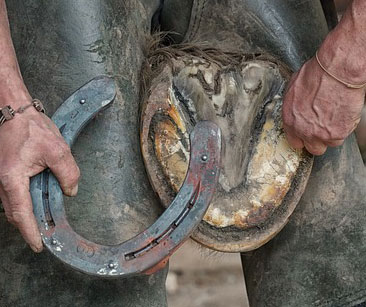
Understanding the Various Types of Lameness in Horses and Ponies
 Lameness is a common issue that affects horses and ponies, hindering their mobility
and overall performance. It can have various causes, ranging from injuries to underlying
medical conditions.
Lameness is a common issue that affects horses and ponies, hindering their mobility
and overall performance. It can have various causes, ranging from injuries to underlying
medical conditions.
In this article, we will explore the different types of lameness in horses and ponies, helping horse owners and riders to better understand this condition.
It is important to diagnose the underlying cause of the lameness and treat it accordingly.
SYMPTOMS OF LAMENESS IN A HORSE OR PONY
Symptoms of lameness include an abnormal gait, reluctance to move, and pain when handled. Lameness can be caused by a variety of issues, such as injury, infection, or poor conformation.
HOOF LAMENESS
Hoof lameness is one of the most prevalent types of lameness in horses and ponies. It can stem from issues such as abscesses, bruises, thrush, laminitis, or even poor farrier care.
Lameness originating from the hoof often presents as an uneven gait, reluctance to bear weight, or visible signs of discomfort. Regular hoof care, including trimming, shoeing, and maintaining clean and dry conditions, are crucial in preventing and managing hoof-related lameness.
TRAUMATIC LAMENESS
Traumatic lameness occurs when a horse or pony sustains an injury, such as a sprain, strain, or fracture. It can result from accidents, falls, or even improper training techniques.
Traumatic lameness is usually characterized by sudden lameness, swelling, heat, and sensitivity around the affected area. Prompt veterinary care is essential to assess and treat the injury properly.
DEGENERATIVE JOINT DISEASE (DJD)
Degenerative Joint Disease, also known as osteoarthritis, is a common cause of chronic lameness in horses and ponies. DJD is a progressive condition that affects the joints and leads to cartilage deterioration. Over time, this can cause pain, stiffness, and limited mobility.
Proper management, including regular exercise, joint supplements, and veterinary guidance, can help minimize the impact of DJD on a horse's comfort and performance.
SOFT TISSUE INJURIES
Soft tissue injuries, including tendon and ligament strains or tears, can cause lameness in horses and ponies. These injuries often occur during intense training or strenuous physical activities.
Lameness resulting from soft tissue injuries can vary in severity, with symptoms ranging from mild stiffness to severe lameness. Rest, veterinary evaluation, and appropriate rehabilitation protocols are essential for successful recovery.
INFECTIOUS CAUSES
Certain infections can lead to lameness in equines. Diseases like Lyme disease,
viral arteritis, and strangles
can cause joint inflammation, resulting in lameness.
Early detection, proper veterinary treatment, and preventive measures, such as vaccination
and insect control, are crucial in reducing the risk of lameness caused by infectious
agents.
OPTIONS FOR TREATING A LAME HORSE OR PONY
Treatment options vary and can include rest, anti-inflammatory medications, and corrective shoeing.
The prognosis for lameness depends on the underlying cause, but early intervention and proper care can usually help to reduce lameness and improve quality of life.
Regular check-ups with a veterinarian are recommended to ensure that any lameness is properly diagnosed and treated.
CONCLUSION
Lameness is a significant concern for horse and pony owners, as it can affect their overall well-being and performance.
By understanding the different types of lameness, horse owners can take proactive measures to prevent, identify, and manage lameness effectively.
Regular veterinary care, proper training techniques, and attentive management practices are key to ensuring optimal health and mobility for these magnificent animals.
Prevention is key to avoiding lameness in horses. Regular exercise, correct nutrition, and proper shoeing should be part of a horse's routine care. Paying close attention to any changes in gait or behavior can help to identify any potential problems early.